
How to Write Your Resume in Reverse-Chronological Order
When setting out to write the perfect resume, choosing a format is an important decision. Reverse-chronological resumes are the standard format, so knowing how to craft one is key! This guide will teach you how to write the best reverse chronological resumes.

What is a Reverse-Chronological Resume?
A reverse-chronological resume is a format focused on relevant work experience.
It is called reverse-chronological because it lists your most recent job first.
All other jobs are then listed from most recent to least recent.
3 key factors help strengthen this type of resume:
- Relevancy: It is important to emphasize the relevance of your previous jobs. The more relevant your previous work experiences are to the job you’re applying for, the better.
- Recency: This format will place your most recent job first in the work experience section. More recent jobs will help an employer see the skills and experience you have gained in the past 1 to 5 years.
- Longevity: Job applicants may have held previous positions for long periods. In this case, emphasizing that longevity is crucial. It helps show employers your ability to commit to a company and position.
Put simply, this resume format is a showcase of your professional experience.
The work experience section will generally be the largest.
Beautiful resume templates to land your dream job

Why and When Do You Write a Reverse-Chronological Order?
Typically, you will want to use the reverse-chronological format as often as possible.
Using this type of resume will automatically give you an advantage.
This is due to the format being highly recognizable by hiring managers.
Reverse-chronological resumes are the standard expected by most employers.
This format is easy to follow and clearly demonstrates a candidate’s experience.
This resume format is especially good to use when applying to entry- to mid-level positions.
The reverse-chronological resume gives you the best opportunity to showcase your experience and accomplishments.
If you do not have much relevant or recent work experience, you may want to consider an alternative format.
Are There Alternatives to Reverse-Chronological Resumes?
When it comes to resumes, there are 3 main formats:
- Reverse-Chronological: A resume focused mainly on work experience.
- Functional: A resume focused on skills, volunteer work, and education.
- Combination/Hybrid: A resume that combines elements of both the reverse-chronological and functional. This format does not place an overwhelming emphasis on any single section.
Choosing between these 3 depends on what experience you have to show.
The following situations may call for the use of a functional or combination resume:
- When a person is returning to work after time away
- If a candidate is still in school or is a recent graduate
- If a professional has decided to change career or industries
Though employers expect to see reverse-chronological resumes, the other two can be just as effective.
It’s all about keeping the format and design simple and easy to follow.
Are you feeling totally lost on which resume format to use? Read our guide on How to Choose the Correct Resume Format in 2024 (with Examples) to learn more!

What are the Main Sections of This Resume Layout
There are four main sections of the reverse-chronological resume:
- Your Name and Contact Information
- Your Work Experience
- Your Education
- Your Skills
The work experience section is often the most prominent on the reverse-chronological resume.
However, the other sections matter as well.
We will go over each of these four main sections to help you understand how to best format your resume.
1. Name and Contact Information
The header of any resume should contain the applicant’s personal information.
This includes:
- Your job title
- Your location
- Your phone number
- Your professional email address
This header will not take up a lot of space on the resume.
Yet, it will be the first thing the employer sees.
Make sure to enlarge and bold your font to help your name stand out.
There are two main formatting options for the header: left-aligned or center-aligned.
A left-aligned resume will have all the information aligned to the left side of the page.
This will include the header and name.
A center-aligned resume will align down the middle of the page.
This can help the name and header to stand out.
However, a center alignment is not often suggested for the remaining sections.
If this is the alignment you choose, only use it on the header.
Here is an example of a header on a reverse-chronological resume:
John Doe, Atlanta, GA Technical Analyst [email protected], 123-456-789
Why It’s Incorrect: In this example, the information is not well-organized and the name doesn’t stand out.
It is best to make the name bigger than the rest of the text.
Bolding and italics can be used to provide better visual organization to the information.
Additionally, the person used an unprofessional email.
This can be a major turn-off to employers.
John Doe Technical Analyst in Atlanta, GA (123) 456-789 | [email protected]
ProTip: Whenever you need to create a professional email, it is best to make one through Gmail. This gives you access to lots of sharing and networking tools. Plus, the Google Workspace is used by many companies!
2. Work Experience
As we have covered, there are 3 main factors to consider when writing your work experience section:
Sometimes candidates will have a lot of work experience, but none that is directly relevant to the new job.
In this case, it is essential to think of ways to tie in your job descriptions to the skills needed for the one you are applying to.
When writing your job descriptions, you should ideally include three bullet points.
These should be short and simple sentences that use action verbs.
If you have quantifiable achievements, these may be included as one of the bullet points.
Here is an example of a work experience section on a reverse-chronological resume:
In this example, the applicant is applying for a job as an office manager at a major firm.
Work Experience Administrative Assistant , Johnson Law Firm June 2019 – May 2021 · Helped to lower overall operational costs · Managed and created schedules · Handled the bookkeeping Bartender , Stir Charlotte, NC | August 2016 – May 2019 · Provided thorough customer service · Helped customers with complaints · Worked alongside a team of 20 servers
Why It’s Incorrect: In this example, the applicant does not provide detailed descriptions and uses weak action verbs. There are no quantifiable achievements or captivating details. Plus, the bartending job is not tailored to show transferable skills.
Work Experience Administrative Assistant , Johnson Law Firm Charlotte, NC | June 2019 – May 2021 · Reduced operational costs by 15 percent by scouting new supply source · Managed the travel arrangements and schedules of the top 5 associates · Optimized the virtual bookkeeping system to be more efficient Bartender , Stir Charlotte, NC | August 2016 – May 2019 · Multitasked by crafting drinks, taking orders, and closing tabs simultaneously · Settled customer complaints with patience and compassion · Delegated side work tasks amongst the serving staff
In this corrected example, the most recent and relevant job has much better descriptions. For the bartending job, the descriptions have been altered to show skills that are useful in an office setting.
For more ideas on more compelling language to use on your resume, take a look at our list of 350+ Action Verbs to Make Your Resume More Effective in 2024 .

3. Education
The education section of a reverse-chronological resume does not need to be very extensive.
In alternative resume formats, such as the functional resume, education may be more emphasized.
For the reverse-chronological resume, there are only 5 key pieces of information to include:
- Your University, College, or School
- Your Highest Degree of Education (Bachelor’s, high school diploma, GED, etc.)
- Your Date of Graduation
- The Location of the School
- Your Area of Study
In some cases, it may be beneficial to include relevant academic experiences or achievements.
As for listing your GPA, it is recommended to only do so when specifically requested by the employer.
Here is an example of an education section on a reverse-chronological resume:
Education The University of Central Florida, Orlando, Florida · Graduated May 2018 · Studied Mass Communications and Business · GPA 3.7
Why It’s Incorrect: This example is fairly disorganized and lacks visual flow. It includes unnecessary information, such as GPA. Plus, it does not list the actual degree earned.
Education The University of Central Florida Orlando, Florida · Earned a Bachelor’s of Business Administration in 2018 · Double-majored in mass communications and business · Received letter of recommendation from the Dean
Keep your education section short and sweet on a reverse-chronological resume.
If you are applying to jobs in the realms of science or academia, you will need to expand your education section.
This will likely require you to write a Curriculum Vitae instead of a resume.
Check out our article on What is the Difference Between a CV and a Resume in 2024 ?
Your skills section is similar to your education section in that it should be short and simple.
Ideally, you should aim to list around 6 skills on your resume.
These should include a mix of both hard and soft skills.
Hard skills are those that require technical knowledge, such as how to use a programming language.
Soft skills are more abstract and emotion-based, such as communication and teamwork.
By including both types of skills, you provide employers with a more well-rounded view of your talents.
Plus, the skills section can be a great place to plug in keywords found throughout the job application and description.
Here are some common examples of hard skills:
- Microsoft Office Suite (Word, Excel, Powerpoint, etc.)
- Google Workspace (Gmail, Drive, Docs, etc.)
- Computer Programming
- Typing Speed
- Cloud Computing
- Project Management
Here are some common examples of soft skills:
- Communication
- Multi-Tasking
- Adaptability
- Conflict Resolution
Additional Sections to Consider Adding to Your Resume
There are, of course, extra sections you can consider adding to your resume.
These include:
- Resume Objective or Summary: A short statement on your professional experience and goals.
- Certifications or Extra Training: Certifications earned through training programs, such as coding courses or First Aid.
- Awards and Achievements: Quantifiable achievements or awards, such as Employee of the Month or Best Salesperson.
- Unpaid Experience: Unpaid internships or volunteer work.
- Languages: A list of languages the applicant can speak, read, or write fluently.
- Interests: Listing hobbies and interests is especially good for resumes lacking broad work experience sections. Interests can be points of conversation for an employer to bring up in an interview.
When including additional sections on a reverse-chronological resume, be mindful of the formatting.
You want the work experience section to remain the focal point.
You also want to keep a good visual flow by not cramming too much information onto one page.
Pro Tip: In a reverse-chronological resume, your work experience section is the most important. Be sure to take your time writing this section and tailoring it for the job.
How Do You Format a Reverse-Chronological Resume?
When formatting your reverse-chronological resume, keep in mind the following 5 elements:
- Length: Ideally, your resume should fill up one page. This page should have 1-inch margins on all sides.
- Bullet Points: Use bullet points under your headers to create descriptions. This makes your information easier to read and skim over for employers.
- Headings: Use bold and enlarged fonts to create your section headings, such as Work Experience and Education.
- Sidebars: Your work experience should take up the most space on the resume. Creating a sidebar for your education and skills will leave more room for work experience.
- Fonts: Use simple and easy-to-read fonts, such as Times New Roman and Arial. Keep headings between 14 – 18 point size and bullet points between 11 – 12 point size.
Need more help organizing your resume? Check out our post on How to Organize Your Resume with Resume Layout Examples in 2024 .
What are Things to Highlight in a Reverse-Chronological Order
With the reverse-chronological resume, work experience is king.
Any accomplishments related to your work experience are the most important information to highlight.
This can include:
- Professional or business-related projects
- Relevant awards and achievements
- Career advancements or promotions
Promotions are particularly important for a reverse-chronological resume.
They help to show a candidate’s commitment, longevity, and work ethic at a company.
For more advice on highlighting promotions, take a look at our guide on How to Show Your Job Promotions on a Resume in 2024.
Final Takeaways
Now that you have a better understanding of the reverse-chronological format, writing your resume will be simple.
Remember these 5 key takeaways when writing a reverse chronological resume:
- The work experience section is the most important in this format. Focus a good amount of time on tailoring this section for the job you are applying to.
- Always use a professional email. Your email is one of the first things employers see. Using an unprofessional email can get your resume thrown out regardless of how well it’s formatted.
- Use your work descriptions to emphasize quantifiable achievements. This is also where you can highlight promotions, projects, or other work-related accomplishments.
- Don’t overstuff your resume with sections. Allow the work experience section to be the main jewel with the other sections serving as accessories.
- Use Bolding, Font Size, and Italics to help specific parts of your resume stand out.
While you’re here, don’t miss out on reading our extensive collection of FREE guides ! Easy Resume offers many resume-building resources.
We have the career advice , resume examples , and templates for you.
Browse more resume templates that fit your role

Get inspired with more resume examples
Read our how-to guides on making your resume perfect, how to list education on a resume in 2024 (with examples & tips).
Not sure what degree to list? If you should include a GPA? It just so happens that there's a variety of ways to effectively list your eduction.
How to Correctly List Certifications on a Resume in 2024 (With Examples)
Follow our step-by-step guide and resume examples to learn how to correctly include certifications on your resume. Make your candidacy stand out and land the interview.
How to Write a Resume Header
Your resume header is the very first thing an employer will see. Not only does it need to contain the correct information, but it needs to stand out as well! In this guide, we will teach you how to write the ideal header for your resume.
How to Describe Work Experience on a Resume in 2024 (Examples & Tips)
Your work experience is a summary of all your hard work, dedication and achievements over the years. Here's how to do justice to your work history.
More advice that will accelerate your career path
How to explain employment gaps on a resume in 2024.
Your journey to discovering your career path can be full of twists and turns. Sometimes, life circumstances can result in gaps in your work history. In this guide, we will teach you all about how to include and explain gaps in your employment to keep your resume looking and sounding strong!
See How This College Student Landed 5 Internships
Learn essential strategies to land your first, second, or even fifth internship as a college student.
15+ Key Interpersonal Skills to List on Your Resume in 2024 (With Examples)
How well you communicate and interact with people is a top priority to employers. In this guide, we will enlighten you on the importance of interpersonal skills. Plus, we will provide you with our top 15 examples to consider including on your resume!
10 Ways to Improve Your Networking Skills in 2024
Mastering the ability to network can be the secret recipe for your long-term career success years beyond 2024. Follow these methods to effectively improve your networking skills.
Professional resume templates to help land your next dream job.

Facebook • Twitter • Linkedin • Pinterest • Crunchbase

Resume builder
Reverse Chronological Order in a Resume
Here’s the thing. As a job seeker, the more your resume stands out, the better your chances of landing the job. And, as research shows, 92 percent of recruiters regard previous work experience as the leading hiring factor . That’s why listing your qualifications and work experience in reverse chronological order is the recruiter’s favorite approach to resume writing.
Want to know more about what a reverse chronological order resume is and when to use it? Keep reading, and you’ll find out.

Table of Contents
What Is Reverse Chronological Order?
Reverse chronological order describes events starting with the most recent and moves backwards in time . For resumes, it means highlighting your most recent job and qualifications first and listing your first job last.
The same goes for education, where the highest education level comes first followed by other schooling details.
Just like with other resume formats, a reverse chronological order resume follows certain rules. For starters, you must quantify your qualifications and list key achievements. Moreover, you need to be concise and use the best font for a resume for faster readability.
This resume format focuses on your work history and professional achievements and is the standard expected by most employers.
The reverse chronological order resume has three key parts:
- Relevancy : The format emphasizes to recruiters the relevance of your experience and job titles to determine if you’re a good fit for the advertised position.
- Recency : Since it lists your most recent job first, recruiters can easily see what experiences you’ve gained in the last five years.
- Longevity : The format makes it easy for employers to see how long you held previous positions. It shows your ability to commit and stay loyal to a company.
Reverse Chronological Resume Example
Here’s a sample resume written in reverse chronological order:

Why Is Reverse Chronological Order the Most Popular Resume Format?
This ordering system is considered the traditional resume format in all industries and professions. For that reason, recruiters and employers are more familiar with it, which makes it easier for them to analyze.
In addition, it seems logical to scan an applicant’s details starting with the current or recent job position and education history. For job seekers, the format makes it easy for them to highlight a consistent career path.
This can prove useful for those applying for a similar position as their previous job.
It Underscores Continuity
One of the top advantages of using reverse chronological order is that it links all your employment dates. A recruiter can immediately see a clear view of your career path, neatly organized in succession.
It also provides an effective way for job seekers to demonstrate their professional growth to potential employers.
Easy to Skim
A reverse chronological order requires that you format your resume in a certain order. You must start with your most recent job, followed by the one before it, and so on.
Additionally, you must provide your position, the company’s name, and the dates worked for each entry list. It’s this order that makes it easy to skim.
Easy for ATSs to Scan
Did you know that over 98 percent of Fortune 500 companies use Applicant Tracking Systems (ATS) in their hiring process? Normally, when there’s a corporate job opening, hundreds of applicants submit their resumes to try their luck.
This would make the work of recruiters an uphill task trying to sort through all those applications. ATS scans and scores these resumes to make it easier for recruiters to find those that meet the most important criteria defined in the job offer.
In other words, an applicant who uses this format stands a better chance of being picked compared to those who use a different format.

The Best Time to Use a Reverse Chronological Order Resume
The reverse chronological resume is ideal for job seekers who want recruiters to see the most relevant and important details about their work history . On top of that, this resume can be useful when:
- You have several years of work experience.
- You want to emphasize a consistent career growth and development, preferably in one industry, and each role you’ve held was more senior than the last.
- You want to apply for a similar field or job post to most of your work history.
- The name of your former employer is significant to your prospective employer.
When You Shouldn’t Use a Reverse Chronological Resume
With that in mind, there are times when a reverse chronological resume isn’t the best format to use. Here are instances when its wisest to consider a different type of resume:
- If you have multiple gaps in your employment history, the format calls attention to these interludes. Unless you have valid explanations, it’s wise to consider either the functional or combined resume formats.
- This format makes it difficult to spot your skills unless you’ve listed them in your most recent job.
- The format won’t favor you if you want to change careers . The employer will not see the relevance of your qualifications if you’re targeting a different position.
- Likewise, you’d want to consider other resume formats if you have heavily varied work experience .
Reverse Chronological Resume Writing Tips and Example
Now that you have a clear understanding of what a reverse chronological resume is, when to use it and when to avoid it, what’s next?
The juicy part – how to write your resume in reverse chronological order.
First things first: the layout
According to research by The Ladders , recruiters are most likely to notice resumes with the following characters:
- Clear and simple logical layouts
- Layouts that have bold job titles supported by bulleted lists of achievements
- An overview at the top
- Clear, eligible fonts
Typically, the reverse chronological resume comprises the following main sections
- Name, job title, and contact information
- Resume objective/summary
- Work history or experience
- Education history
- Skills and strengths
- Additional sections
Let’s take a detailed look at how you can make each section of your reverse chronological resume shine:
Name, Job Title, and Contact Information
This section might seem like a no-brainer, but you must be careful how you approach it. This is the header of your resume and will be the first thing employers see. So, you’d want to make sure it’s crafted correctly.
The details of this section include:
- Your job title
- Your location
- Your email address
- Links to your portfolio, blog, or social media profiles
Here’s a good example :
Gladys Dawson Nurse in Atlanta, GA (123) 456-899 | gdawson @ gmail.com www.linkedin.com/in/gladys-dawson
Resume Objective/Summary
This is the first section of your resume that captures, in summary, what you can offer if hired. It focuses on previous experience (relevant to the position) and applies to candidates who have worked for at least two years. Use this section to highlight your skills and strengths.
We recommend to use some modern solutions to save some time: use AI resume builder to write autogenerated objective and summary for your profession.
Work History or Experience
In this section, you want to be as precise and accurate as possible. False or erroneous information is something employers don’t tolerate. This is just one of many resume mistakes that can be instant deal breakers for employers.
Here are tips to make the most of your professional experience in a resume:
- Start with the most recent position at the top and follow it up with the previous one. After all, you’re following a reverse chronological order.
- Indicate the dates worked, the company’s name, and the job title for each position listed. If necessary, add the company’s location.
- Make your work scannable by including at least three bullet points . They should be short and simple sentences describing your responsibilities and any quantifiable achievements. Start each bullet point with strong action words, such as achieved, boosted, delegated, etc.
- Create a special subsection for key achievements .
- Demonstrate only the experience that’s relevant to the position you’re applying for.
Read more about how to write good resume bullet points .
Education History
If you don’t have much experience for the job position but have the qualifications to show for it, you can start with the education section. Follow this up with the work experience section.
Otherwise, the reverse chronological resume favors the experience section more than any other element. If you have years of work experience and want to highlight all of them, the education section doesn’t have to be extensive.
With this format, you only need to include five key pieces of information . These are:
- University, College, or School
- Your highest level of education
- Year of graduation
- The school’s location
- Area of specialization (study)
You can include any relevant academic achievements or experiences that you feel are beneficial to the job position.
Employers will be interested to see the skills you’re good at. Consider listing around six skills , making them short and simple. More importantly, the skills should be relevant to the position you’re applying for.
You should list both hard and soft skills . Hard skills comprise those that require technical or job-related knowledge, for example, coding and analytical skills.
Soft skills can be personal qualities or traits that help you get along with others. They are commonly known as “people skills.”
A CareerBuilder survey shows that 62 percent of job descriptions list management and leadership as desired soft skills. Others include interpersonal skills and innovation and creativity skills.
Additional Sections
There’s nothing wrong with wanting to earn extra points from a potential employer. The additional sections of a resume allow you to emphasize other relevant facts that make you stand out from the crowd.
Just remember to be mindful of the formatting. You don’t want to draw attention away from the work experience section. Another thing to keep in mind is to only add parts that will boost your chances of employment.
Here are some ideas:
- Certifications or extra training, such as dropshipping or digital marketing courses
- Unpaid experiences, like volunteer work
- Awards and achievements, e.g., Employee of the Month Award
- Languages. List languages you can write and speak proficiently
- Interests and hobbies
Avoid cramming too much information into this section. You want to ensure a good visual flow of information that’s scannable.
What Are the Top Resume Formats?
Applying for jobs is no mean easy. To come out on top, you must be creative and pick the right resume format based on the job you’re applying for.
Generally, there are three main resume formats :
- Reverse-chronological : As we mentioned earlier, the reverse chronological resume format is the most popular. It lists your work history in reverse order, starting with your current or most recent job at the top.
- Functional (Skill-based) : This format focuses more on relevant skills than work experience. It highlights what you’re good at (skills and abilities) and takes the pressure off of your employment history. It’s ideal for graduates who have the skills necessary for the job but not much work experience.
- Combination (Hybrid) : This format blends the resume elements of a chronological and functional resume. It emphasizes both skills and work history.
Key Takeaways
Armed with these fundamental principles of creating a reverse chronological resume, you shouldn’t have a problem writing one yourself. Remember, stick to simple fonts, use bold text to show prominence, focus on your achievements, and do not lie or mislead recruiters.
Leave a Reply Cancel reply
Your email address will not be published. Required fields are marked *
Save my name, email, and website in this browser for the next time I comment.

How to Decide Whether to Use the Reverse Chronological Resume
Written by Doroteya Vasileva
In This Guide:
What is the reverse chronological resume format
Benefits of the reverse chronological resume
Who is the reverse chronological resume for
Is the reverse chronological resume format right for you
66 Reverse chronological resumes
Why is the reverse chronological resume format better
How to write a reverse chronological resume
What’s at stake when using a reverse chronological resume
Chronological or reverse chronological resumes
The truth about reverse chronological resumes
Reverse chronological vs functional vs combination format
Key takeaways

The reverse chronological resume is the most common resume format out there, but is it impactful?
Today’s hiring landscape requires you to not only provide recruiters with information but to package it in a way that they remember. Especially when there’s a tsunami of applicants arriving at their desks.
Everyone is reduced to a piece of paper when it comes to resumes, so how can you make yours as effective as possible?
See the benefits of the reverse-chronological resume and examples of how others have used it in their job application process below. Or explore our professionally designed chronological resume templates instead!
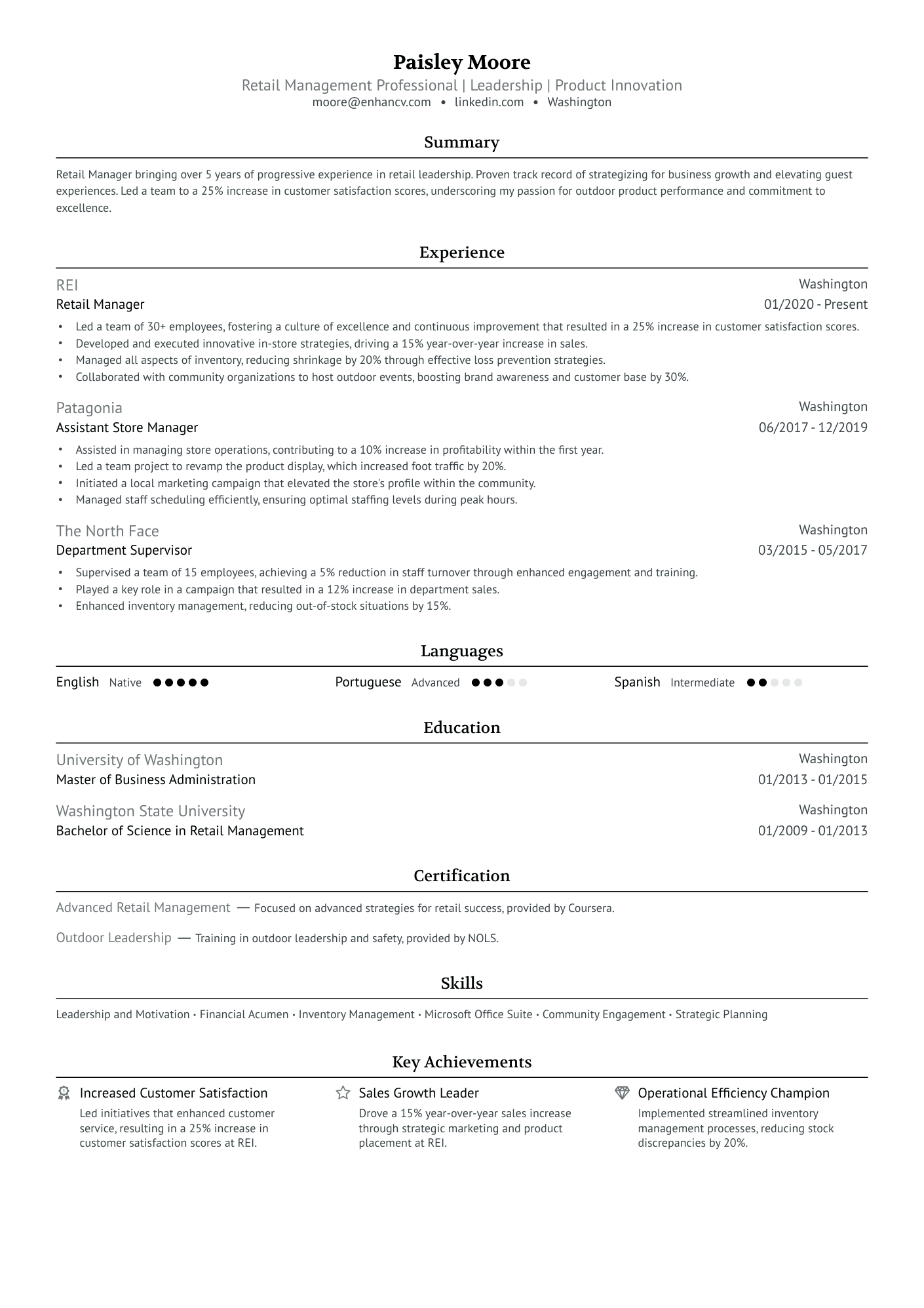

Is your resume good enough?
Drop your resume here or choose a file . PDF & DOCX only. Max 2MB file size.
What is the Reverse Chronological Resume Format?
The reverse-chronological resume describes the most recent job first and moves backward in time for every subsequent position.
The format comes with the following general expectation of flow:
Resume header
- Personal summary
- Work experience
- Skills section
- Optional - any other relevant sections that make sense for the job you’re targeting. For example, projects, volunteering, or languages.
While this is the convention, it’s certainly not the law. You can keep the spirit of a reverse-chronological resume without sticking to a restricting structure. We’ll get into this further on in the article.
Read our full guide about resume sections to confidently optimize a stronger resume that’s more likely to attract job recruiters!
What Are the Benefits of Using a Reverse Chronological Resume?
Going with a reverse chronological resume format can really boost your job application. This style has some great benefits that help show off your career growth and achievements in the best way possible. Here’s what a reverse chronological resume will help you achieve:
Provide a clear narrative of your career
Inconsistencies inyour career history are one of the first red flags recruiters will notice. Especially since recruiters spend just 6 seconds on initial screenings, your resume can easily be overlooked.
The recruiter is interested in the story of your career — including what brought you to this current position. This can play into your culture fit and your impact on the team dynamics within the organization.
To illustrate this, let’s see what Jonathan, one of Enhancv’s customers, wrote on his resume.
- • Logged over 1,000 incoming and outgoing food donations into the inventory database within the Logistics department.
- • Collaborated with 10+ beneficiary centers to project demand and prepare outgoing food pallets.
- • Partnered with 15 local businesses to initiate food donations and maintained relationships with current donors.
- • Compiled and analyzed performance and workload data for 50+ research centers across the country.
- • Produced fiscal year retrospective reports on trends and analyses and quarterly reporting of key performance metrics.
- • Prepared and participated in 10+ briefings for senior leadership of the Agency on performance trends.
- • Developed content and compiled a weekly electronic report distributed to over 500 employees, detailing upcoming events, deadlines, vacancy opportunities, and employee spotlights.
- • Served as confidential assistant to the Director, trusted with sensitive information, and engaged in discussions to improve team performance, streamline processes, and enhance operational efficiency of administrative service delivery.
When Jonathan was getting his job at HEB (one of the largest grocery retailers in Texas), he used the reverse-chronological order with Enhancv’s resume builder to highlight his journey into operations from data analytics. Because of this, job recruiters were able to estimate his skill level and recognize his commitment to the area.
Line up with recruiters’ expectations
Sometimes the traditional route is best. This can come into play when applying to large organizations with standardized application forms or those who rely on Automated Tracking Systems (ATS).
With the reverse-chronological resume being the most common, it’s easily analyzed by the ATS and gives recruiters exactly what they’re looking for. They can directly identify your most recent job and quickly assess how that experience compares to what you’ll be doing.
As the saying goes, “You’re only as good as your last performance”.
Have big names play in your favor
One of the advantages of using this format is that it emphasizes the organizations you’ve worked at previously. If you’ve worked with some heavy hitters in your industry, this can create a great impression on the hiring managers and separate you from the crowd.
- • Helped establish the Disney Cruise Line brand leading up to and including the maiden voyage of the Disney Magic.
- • Worked in partnership with Disney alliance partners (Coca-Cola, General Motors, American Express, et al) to achieve synergy as an extension of other Disney brands.
- • Selected to serve with elite Event Services division to coordinate and execute the press event for the 25th Anniversary of Walt Disney World.
- • Honored with prestigious Partners in Excellence award, internal recognition for top 2% Cast Members (employees) - the highest recognition within the Walt Disney Company.
Who is the Reverse Chronological Resume For?
There are 4 common cases when you’d need to provide a reverse chronological overview of your experience. It’s best for:
- Professionals with a consistent work history : If you have a stable career progression, the chronological resume format highlights it, showing potential employers your growth and reliability over time.
- Individuals advancing in their career : If you're aiming for a higher position, the reverse-chronological resume style emphasizes your most recent roles and accomplishments, proving you're ready for the next step.
- Job seekers in the same industry : If you're staying within your field, this chronological format makes it simple for employers to track your career development and relevant experience.
- Students and recent graduates : If you're fresh out of school, this format showcases your latest achievements and education, making it easy for employers to see your most relevant experiences first. (Yes, even your education section entries should be listed in reverse chronological order).
Is the Reverse Chronological Resume Format Right for You?
Your best bet would be to craft a resume using one of the other two formats to make your employment gaps less obvious . For example, the hybrid resume allows you to highlight your skills rather than your career progression, providing a good workaround.
We recommend avoiding this format if you're in an entry-level role or have mainly temporary work experience.
Just remember, whichever format you choose, list your experience, internships, education, and achievements in reverse chronological order.
Reverse Chronological Resume Samples for 66 Job Titles
Below is a comprehensive list of jobs where the reverse chronological resume can best fit a candidate’s substantial experience.
Here are some job roles where this format is particularly advantageous:
- Senior executive (CEO, CFO, COO) : For senior executives, a reverse chronological resume highlights an extensive career trajectory and leadership roles. It allows you to demonstrate your experience in managing companies, driving strategic initiatives, and leading large teams.
- Medical professional (doctor, surgeon, nurse) : Medical professionals benefit from the reverse chronological format as it details their clinical experience, residency, and fellowship training. It also emphasizes your professional development and the increasing responsibility you’ve taken on over time.
- Academic (professor, research scientist ): Academics and researchers often have a long history of positions, publications, and research projects. The reverse chronological resume allows you to showcase your educational background, academic appointments, and contributions to your field in a structured manner.
- Attorney (lawyer, legal counsel) : Lawyers and legal professionals can use this format to outline their careers in the legal field, including positions held at different law firms, types of cases handled, and any significant legal victories.
- Engineer (civil, mechanical, electrical) : You can benefit from this format as it highlights your technical experience, projects completed, and roles within various companies. It provides a clear timeline of your professional development, certifications, and advancements in your engineering career.
- Sales manager : Use a reverse chronological resume to demonstrate your sales achievements, leadership roles, and the progression of responsibilities. This format is ideal for showcasing a history of meeting or exceeding sales targets and managing sales teams.
- IT manager/director : IT professionals with extensive experience can use this format to highlight their roles in managing IT infrastructure and leading technology projects. It allows employers to see your growth and contributions to previous organizations.
- Marketing director : For this role, the reverse chronological resume helps to emphasize your experience in developing and executing marketing strategies, leading teams, and career growth within the marketing domain.
- Financial analyst : You can use this format to present your career progression, from entry-level analyst roles to senior positions.
- Operations manager: Operations managers benefit from a reverse chronological resume by detailing their roles in improving operational efficiency, managing logistics, and overseeing day-to-day operations. This format underscores your career development and achievements in optimizing business processes.
Here are the job titles by sector:
Accounting & finance
- Accountant Resume
- Financial Analyst Resume
- Auditor Resume
- Business Analyst Resume
- Business Development Resume
- Business Intelligence Resume
Creative
- Artist Resume
- Writer Resume
- Videographer
Data science
- Data Scientist Resume
- Data Architect Resume
- Data Engineer Resume
- Designer Resume
- UX Designer Resume
- App Designer Resume
Engineering
- Engineering Resume
- Mechanical Engineer Resume
- Industrial Engineer Resume
- Product Engineer
- Automotive Engineer Resume
Executive and management roles
- Executive Resume
- IT Director Resume
- Chief Marketing Officer Resume
Foodservice and hospitality
- Chef Resume
- Restaurant Operations Manager Resume
- Hospitality Manager Resume
- Food and Beverage Manager Resume
Government and federal agencies
- Military Resume
- Government Resume
- Federal Resume
Human resources
- HR Manager Resume
- Director of Operations Resume
- HR Business Partner Resume
Information technology
- Computer Science Resume
- Information Security Engineer Resume
- Software Engineer Resume
- Web Developer Resume
- Tech Resume
Law enforcement
- Police Officer Resume
- Law Enforcement Resume
- Lawyer Resume
- Attorney Resume
- Legal Assistant Resume
Manufacturing
- Procurement Manager Resume
- Supply Chain Manager Resume
- Marketing Director Resume
- Digital Marketing Manager Resume
- Brand Manager Resume
Nursing and healthcare
- Doctor Resume
- Nurse Resume
- Psychologist Resume
Project management
- Project Manager Resume
- Product Manager Resume
- Program Manager Resume
Sales and retail
- Sales Resume
- Sales Executive Resume
- Sales Engineer Resume
- Scientist Resume
- Researcher Resume
Teaching and education
- Teacher Resume
- Teacher Assistant Resume
- School Counselor Resume
Quality assurance
- Quality Assurance Engineer Resume
- Quality Assurance Analyst
- Test Engineer Resume
Why is the Reverse Chronological Resume Format Better?
The reason is relevance. On your resume, you should always prioritize experiences and skills directly related to the job you're applying for. Your most recent work experience provides a better reflection of your current qualifications than a job you did 5 years ago. The same applies to your educational progression.
By placing your latest experience at the top, you direct hiring managers’ attention to your most relevant achievements first. This allows them to quickly assess how well you’ll perform in the prospective job. Plus, this format ensures that the most pertinent and updated information is highlighted, making it easier for employers to see your fit for the role.
Always tailor your resume to the job you’re applying for . Don’t list everything that comes to mind just to fill up space. Instead, select keywords from the job description and strategically incorporate them into your resume. This will help you pass the ATS screening and make it easier for recruiters to read through your document.
How to Write a Reverse Chronological Resume
You’ve probably seen a resume in reverse chronological order before—this is the most common type of resume and it's all over the internet. However, we’re here to give you some quick tips on how to craft yours step by step, along with some insider guidelines on mistakes to avoid.
The reverse chronological resume template should have the following sequence:
The top sections on a reverse chronological resume
- A clear and informative header that doesn’t leave recruiters guessing who’s applying for what.
- A compelling resume summary or objective that gives hiring managers an overview of your professional expertise and qualifications.
- A detailed and targeted resume experience section showing your fit for the role.
- A concise education section listing your most relevant academic accomplishments and certifications.
- A skills section showcasing the tools and techniques you’re most experienced in.
- An optional additional section with your top achievements, projects, or publications (whichever is most relevant to the job you’re targeting).
You may wonder what makes these sections so typical of the reverse chronological format. It’s the visual hierarchy they create on the resume. A clear and predictable organization makes it easier for recruiters to read and assess your qualifications, making them more relaxed and engaged with your resume.
Let’s tackle these sections one by one.
The resume header is the section at the top of your resume and serves as the first point of contact for recruiters. It's often personalized with contrasting colors and a larger font size to attract attention. It should contain the following details:
- Contact information : State your name, job title, and location. Ensure your contact information is professional, including an email address.
- Links : Include a link to your professional portfolio or your LinkedIn profile .
- Resume photo : Generally, it’s best to omit photos to maintain focus on your qualifications and avoid potential biases.
Mistakes to avoid
Not making your name searchable. To make it easier for recruiters to find your resume in a sea of candidates, ensure your name matches your LinkedIn profile, the email address, and the file name.
Resume profile
A resume profile is a section that includes a brief overview of your previous experience, skills, and future goals related to a specific job opening. We normally distinguish between two types—a career summary and an objective statement. Here’s how to write yours:
- A short paragraph : Depending on your level of experience, write 3-5 sentences that highlight your best qualities, skills, and career goals. (Learn more about objective statements and how they differ from a resume summary).
- Choice of words : Use strong adjectives to describe yourself and start each sentence with a dynamic verb. Avoid writing in the first-person perspective .
- Finish up strong : Use the final sentence to reinforce your message. Make recruiters want to learn more about you.
Writing a resume summary or objective that’s too vague or generic. Ensure your profile is specific, tailored to the job you’re applying for, and highlights your unique qualifications and career goals.
Resume experience section
Your work history section determines the format of your resume. Senior candidates can benefit greatly from listing experience in reverse chronological order, while entry-level individuals should go for a hybrid or functional resume.
This is how your experience entries should be listed:
- Job title and company : Clearly state your most recent position and the company you worked for.
- Dates of employment : Include the month and year you started and ended each job. You also have the option of ticking “Ongoing” on the Enhancv’s resume builder.
- Job description : Optionally, add a short description of your role in the company , especially if it was a startup or an NGO—recruiters will need more context about it.
- Bullet points : Write 3-5 bullet points about your main tasks, duties, and contributions. Whenever possible, include numbers or statistics to illustrate your impact (e.g., increased sales by 20%, managed a team of 10).
- Relevant skills : Mention the skills you developed or used in each position that are pertinent to the job you’re applying for.
- Action verbs : Start each bullet entry with an action verb to showcase your initiative.
An experience section that doesn’t provide quantifiable results. Don’t just list job duties—include concrete numbers to make your impact tangible.
If you need a more detailed breakdown of how to build your experience section, dive into our article: How to List Work Experience on Your Resume—A Guide with Examples .
Resume education
Your education section also needs to follow a specific hierarchy to be more readable. See the steps below:
- Degree : Start with the highest degree you’ve obtained (e.g., Bachelor’s, Master’s, Ph.D.) and your major or field of study .
- University or college : Include the name of the institution where you earned your degree.
- Location : Mention the city and state (or country, if international) of the institution.
- Graduation date : Provide the month and year of your graduation. If you’re still studying, indicate your expected graduation date .
- Honors and awards : If applicable, list any honors, awards, or distinctions you received (e.g., summa cum laude , Dean’s List ). If you’re fresh out of school, your GPA might come in handy, but only if it’s above 3.5.
- Relevant coursework : Optionally, include coursework relevant to the job you’re applying for, especially if you’re a recent graduate or changing careers .
Omitting important details. Make sure you include all critical information to ensure clarity and completeness.
Resume skills
Resume skills help potential employers identify whether you would be a good fit for the role. Consider the whole process from the recruiter's point of view. They’ll either briefly skim the document to identify relevant skills or work with ATS to identify them. Use the tips below to make your skills section count:
- Hard skills: If your job relies on software or specific tools, list your technical skills in a dedicated section on your resume.
- Soft skills : Unlike hard skills , which can be validated by certifications, soft skills are harder to prove. Integrate them into other resume sections and provide concrete examples of how you’ve demonstrated these skills.
- Relevance : Always prioritize listing skills that are specifically required in the job description.
Including irrelevant or generic skills that don’t align with the job you’re applying for. Always tailor your skills to match the job description, ensuring they’re specific and relevant to the position. This will make your resume more targeted and appealing to employers.
Additional sections
Depending on the job you’re applying for, inserting more sections into your resume can add value to your application.
- Space : Only add extra sections if you have enough space. A one-page resume is usually sufficient unless you have over 10 years of experience or are in a C-level position.
- Tailored approach : Choose sections based on the job requirements. For example, if you lack direct experience , you might include a “Hobbies & Interests” section to show how your leisure activities relate to the role.
- Common additional sections : Certifications , languages , and projects are often even mandatory for certain jobs. The key here is to include those that will strengthen your application the most.
Overloading with information and irrelevance. Providing too much detail can make the resume poorly targeted, lengthy, and difficult to read. Aim for conciseness and relevance.
Reverse chronological resume example — SEO Content Specialist
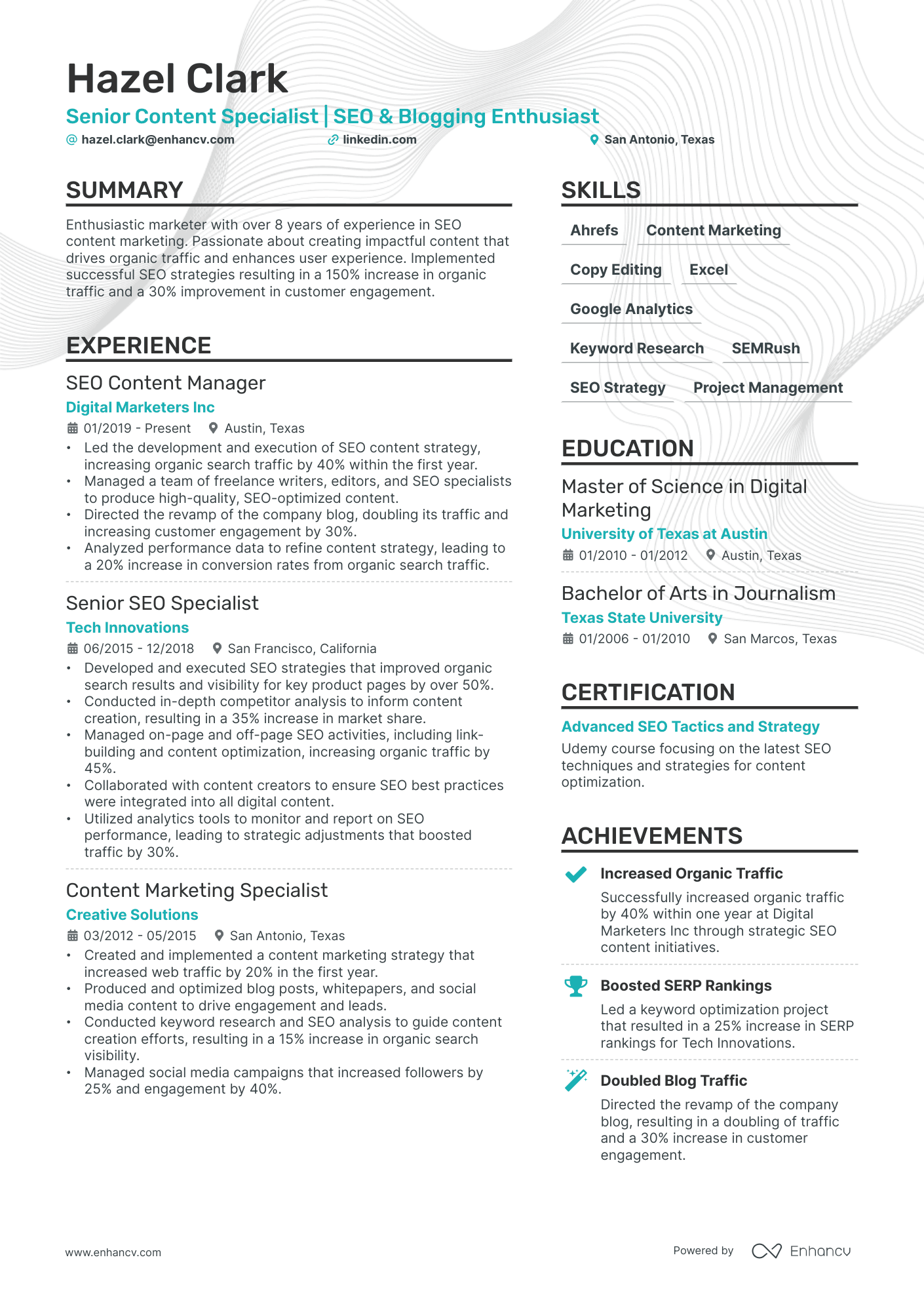
Reverse chronological resume example — IT Specialist
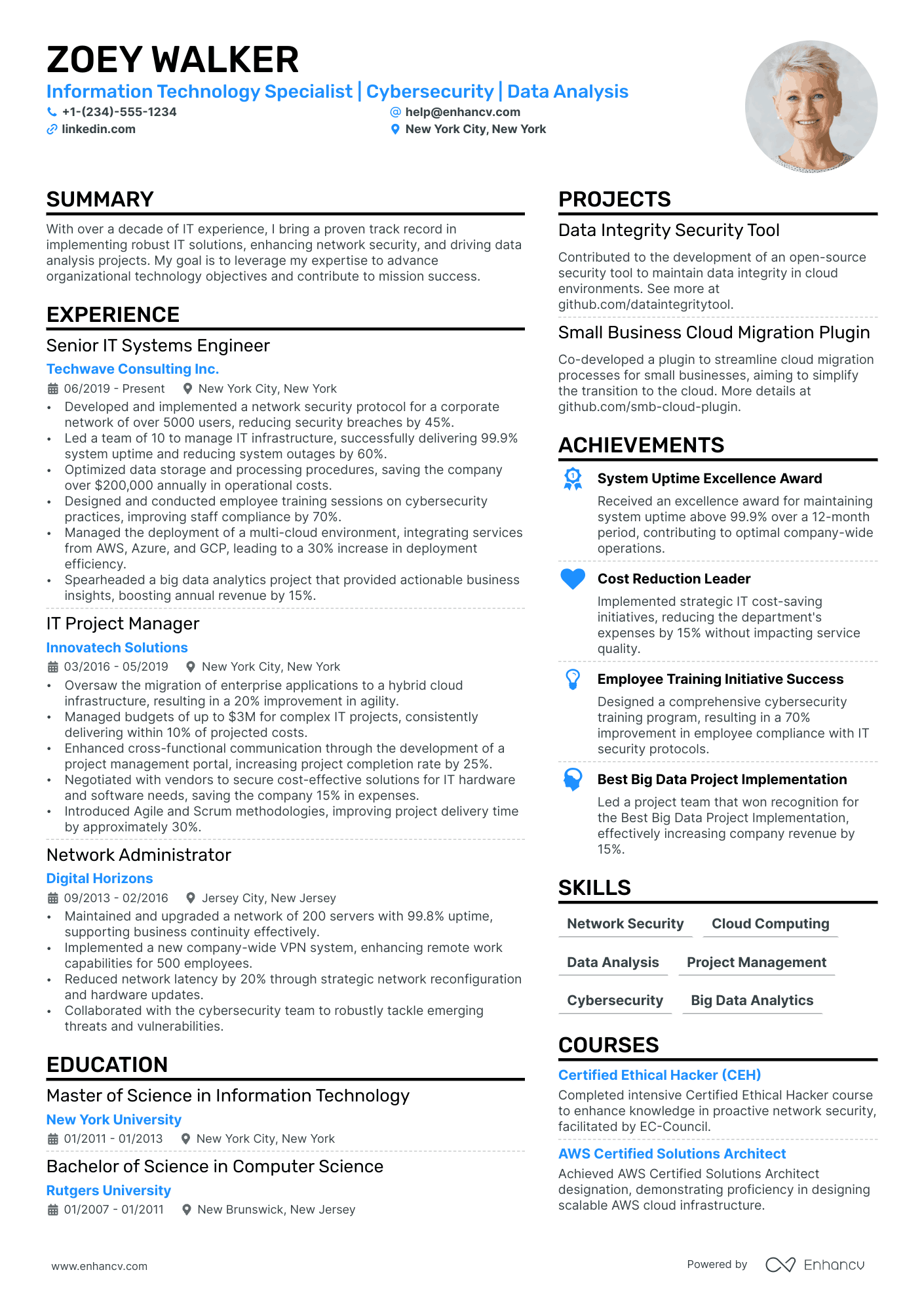
Reverse chronological resume example — Accountant
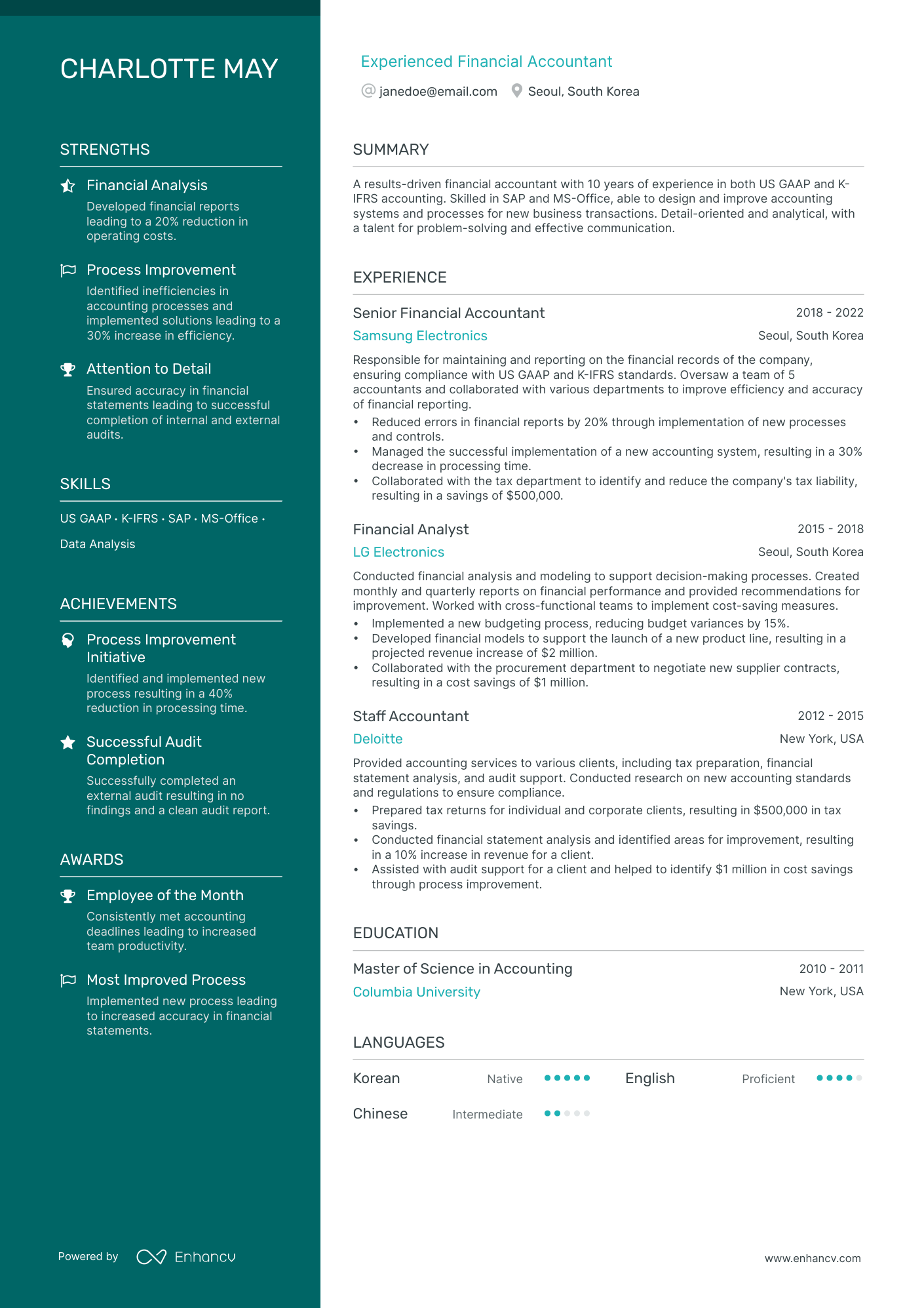
Reverse chronological resume example — Project Manager
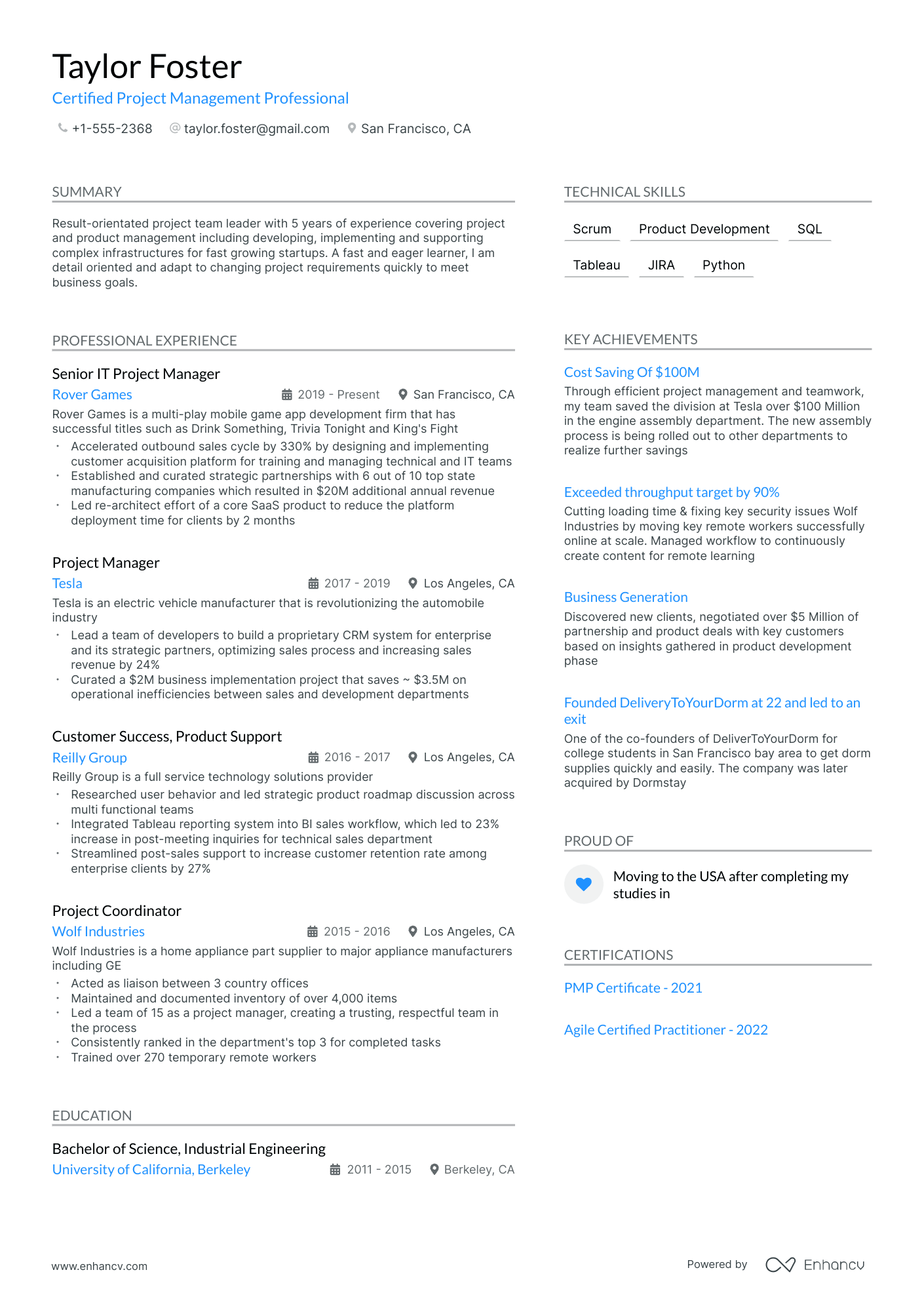
Reverse chronological resume example — Product Manager
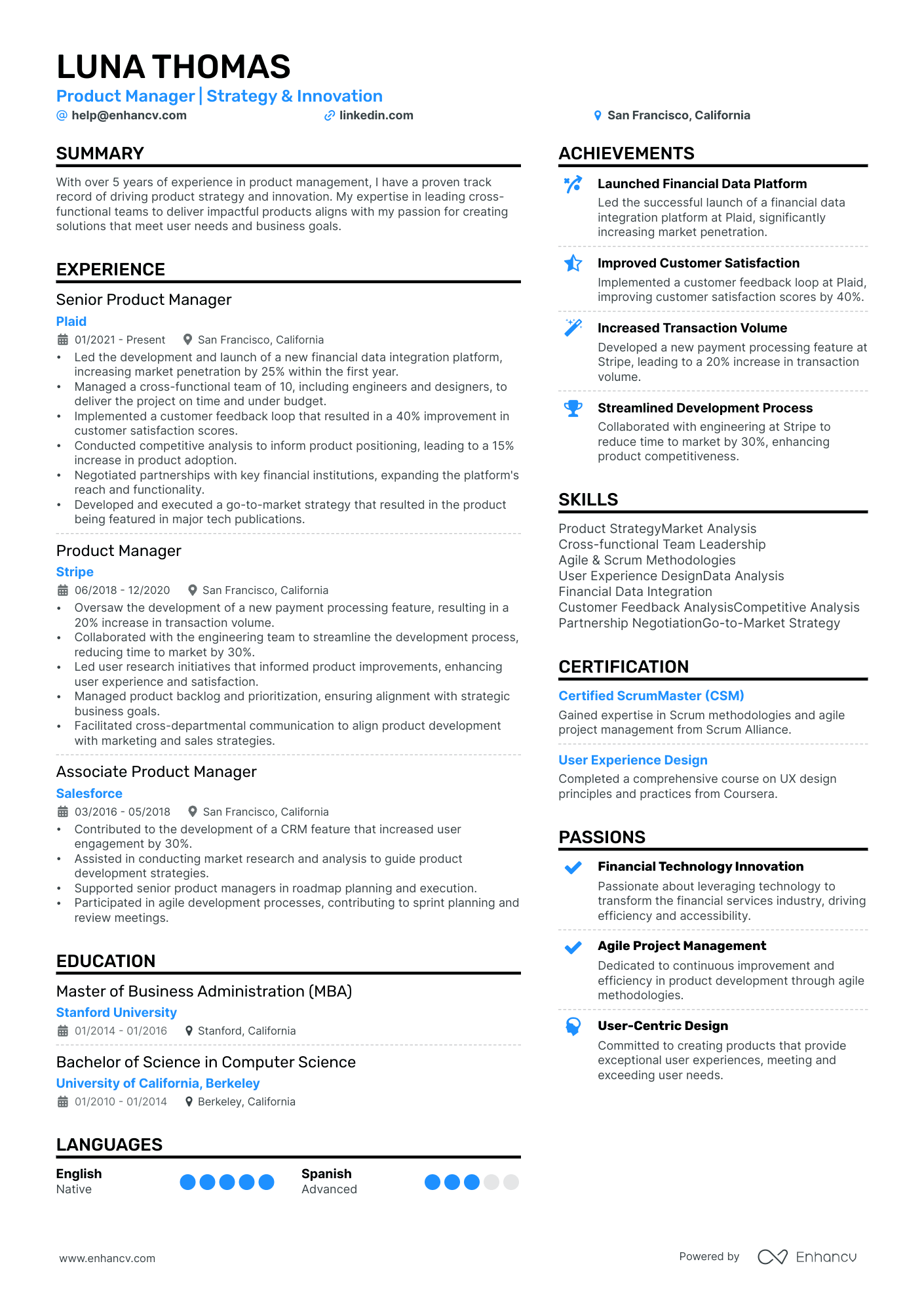
Reverse chronological resume example — Executives
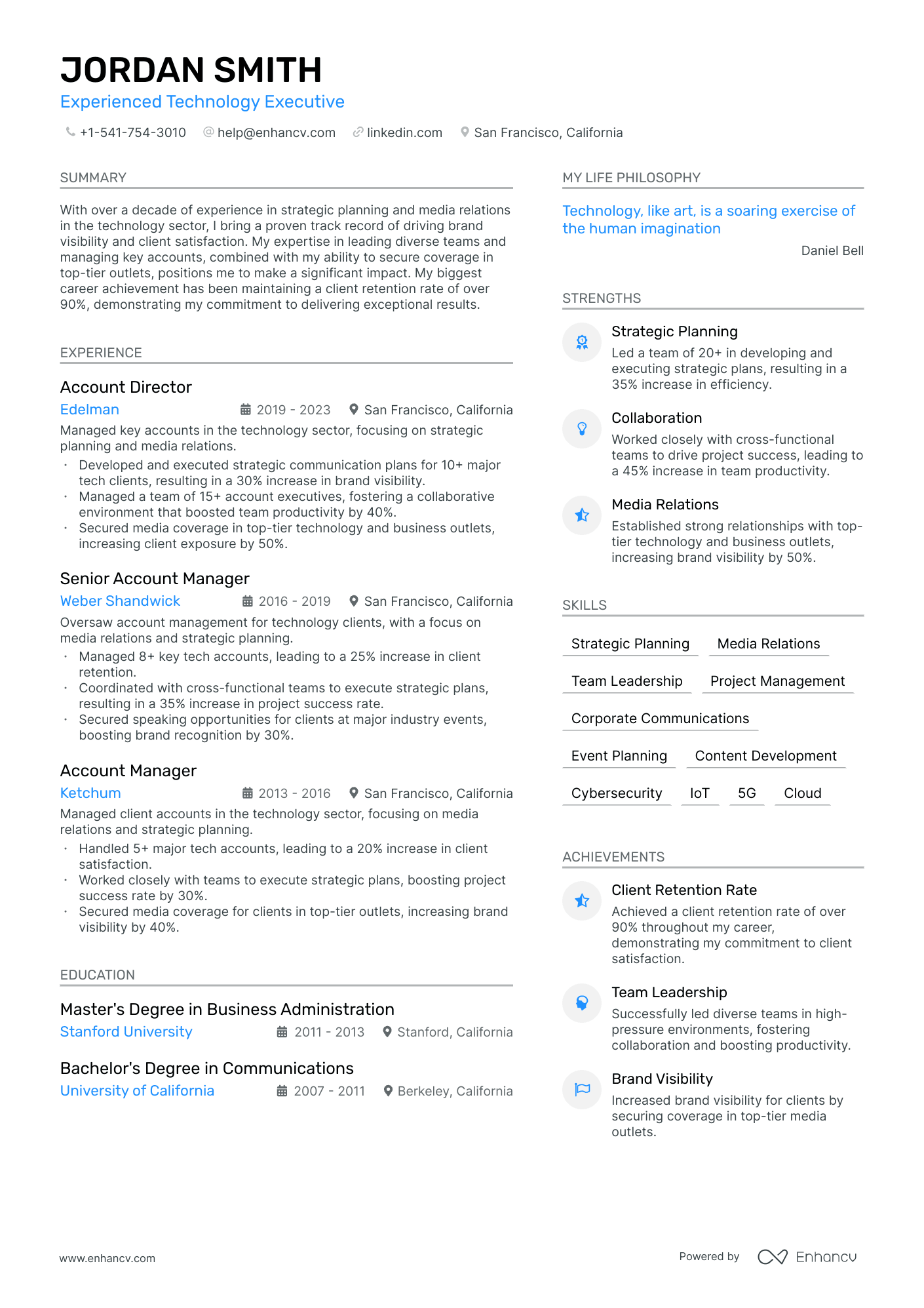
Reverse chronological resume example — Doctor
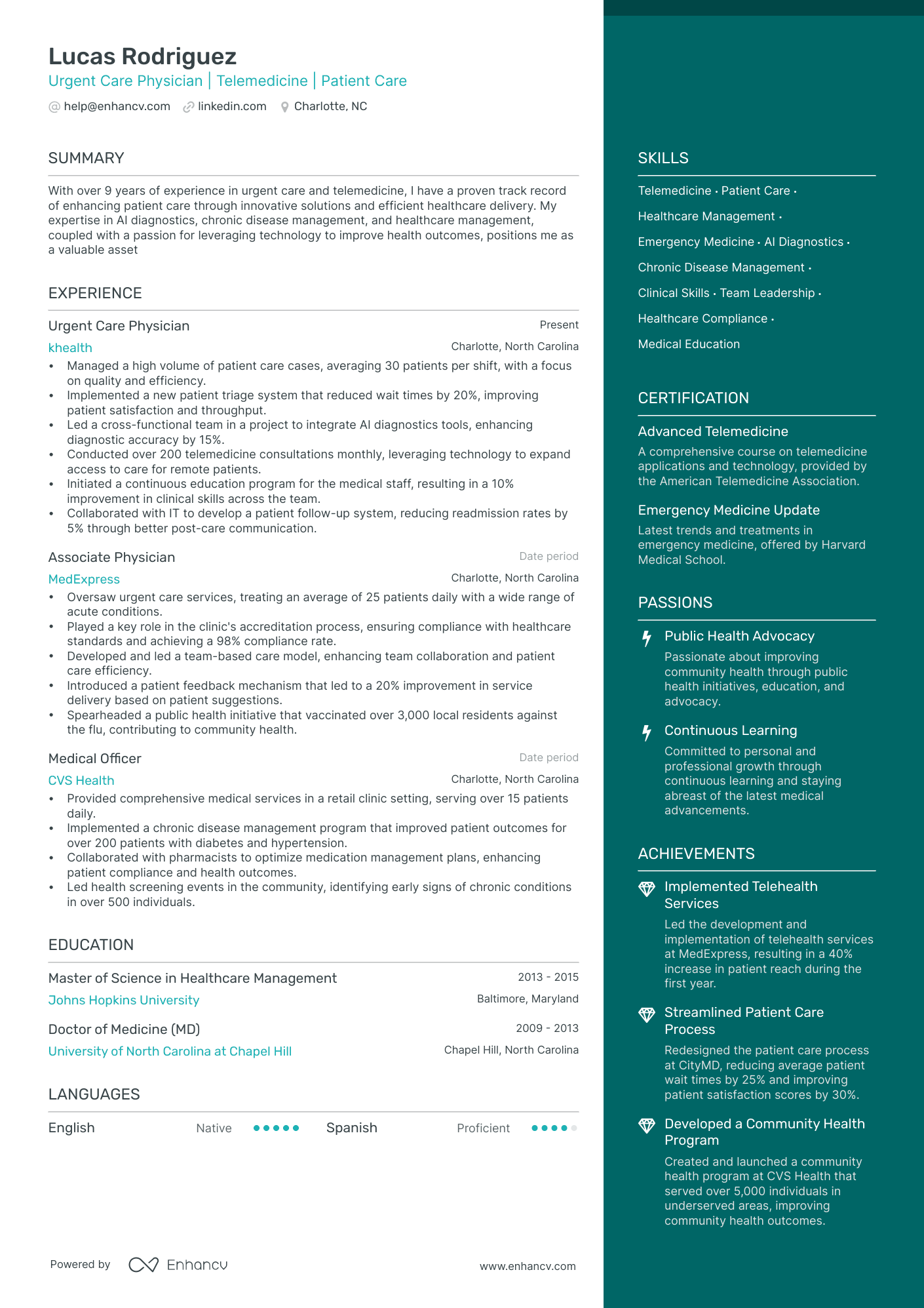
Reverse chronological resume example — Financial Analyst
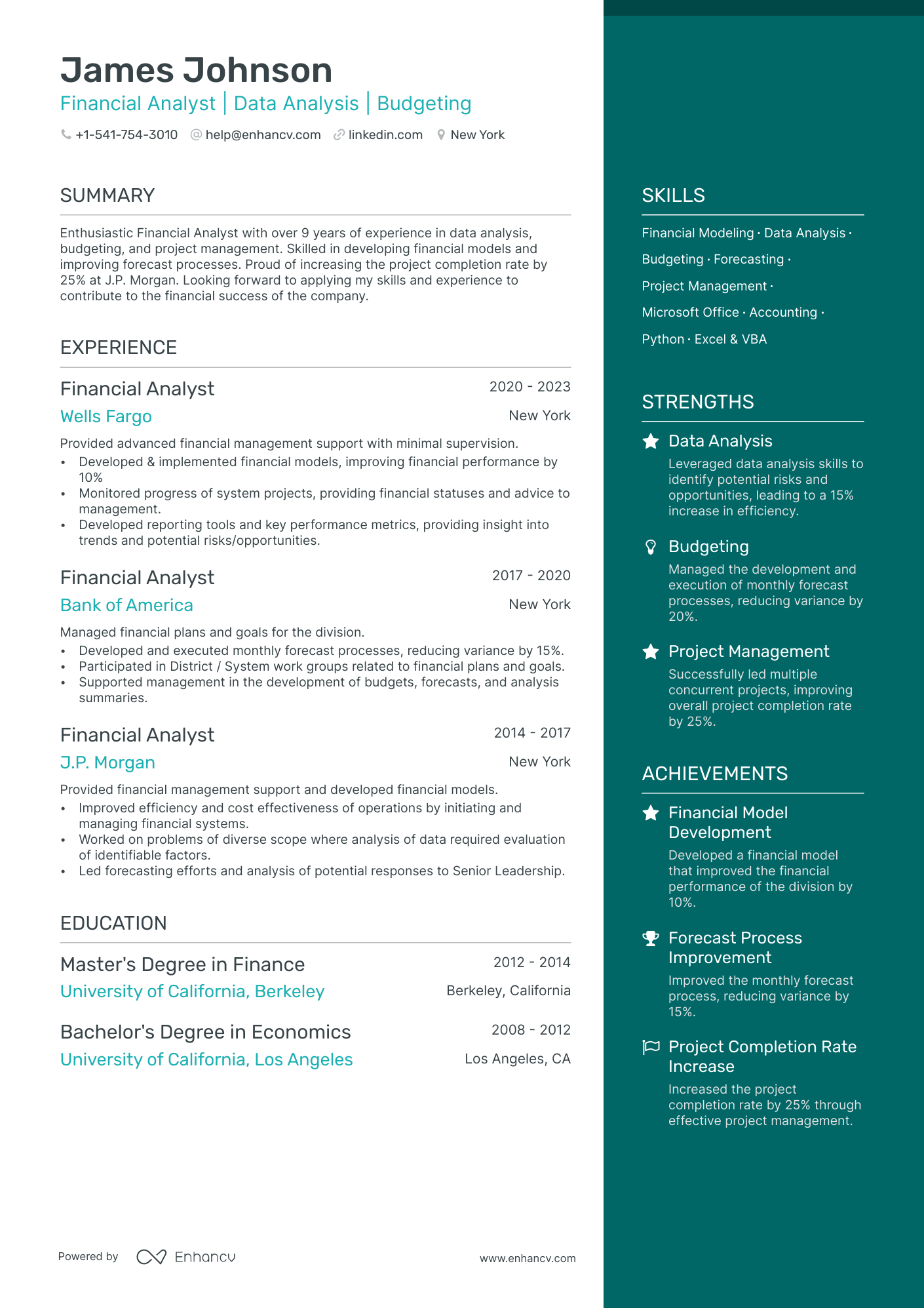
Reverse chronological resume template
[Your Name]
[Your City, State, ZIP] | [Your Phone Number] | [Your Email Address] [LinkedIn Profile] | [Professional Website or Portfolio]
Professional summary
A concise summary highlighting your key qualifications, skills, and career goals. Typically 3-4 sentences.
Professional experience
[Most recent job title] [Company Name], [City, State] [Month/Year] – [Month/Year]
- Optional description.
- [Action verb] [your duty and/or accomplishment] [quantified results].
[Previous job title] [Company Name], [City, State] [Month/Year] – [Month/Year]
[Earlier job title] [Company Name], [City, State] [Month/Year] – [Month/Year]
[Degree Earned] [University Name], [City, State] [Month/Year] – [Month/Year]
- Relevant coursework: [Course Names]
- Honors and awards: [Any relevant honors or awards]
Certifications
- [Certification Name], [Issuing Organization], [Month/Year]
- Technical skills: List relevant technical skills
- Hard skills: List role-specific practical skills
- Languages : List any languages spoken, if applicable.
- Professional affiliations
[Organization Name], Member since [Year]
- Projects (if applicable)
[Project title] [City, State] [Month/Year] – [Month/Year]
Description of responsibilities and achievements.
What’s at Stake When Using a Reverse Chronological Resume?
Here are some of the considerations that pop into mind when creating a reverse chronological resume.
Gaps in your resume become more noticeable
“Do they still possess the same skills they had X years ago?” “Will they be able to adapt to the current market?”
These are just two of many possible questions the recruiter might not even spend the time to try and get an answer.
A chronological timeline will make the gaps in your career more apparent. If it's been a couple of years since your most recent job, that can be a red flag for the recruiter.
(Tip: One way to overcome this difficulty is to describe other projects or skills you’ve developed during the break.)
Harder to navigate through different sectors
Let’s say you have experience in both music and marketing. You’ve spent the last five years pursuing jobs in music, but now you’re looking for a new job in marketing.
In this case, it might make sense to use a reverse-chronological resume format. However, sticking to this structure could make your experience seem irrelevant. This makes it even harder for you, especially when you’re trying to move through the different areas that you’re skilled in.
(Tip: When building your resume, only select experience that’s relevant to the position you’re applying for).
Not optimal for first-time job seekers
With prior experience being the crux of this resume format, it’s going to be difficult to write your first resume in reverse chronological order. For this reason, this format is not suitable for those entering the job market or applying for volunteer positions for the first time.
(Tip: Go for a skills-based resume and make your strengths and talents shine through).
Chronological Or Reverse Chronological Resumes?
Chronological and reverse chronological resumes are often used interchangeably as they refer to the same format. They both mean listing your work experience starting from the most recent position and moving backward in time.
However, we use the more precise convention—reverse chronological—to avoid confusion.
The Truth About Reverse Chronological Resumes
This is a traditional format and it’s great for organizing your experience. Still, keep in mind that reverse chronological resumes are far from one-size-fits-all.
In reality, your resume should be tailored to the position you’re applying for . That’s what we call a targeted resume . This may mean starting with a less recent job first as long as it’s more pertinent to the prospective role.
With Enhancv’s resume builder, you can describe your previous experience in modular segments that can be moved as pieces to any place on your resume. This makes positioning easily streamlined, so you don’t have to worry too much.
Overall, you’ll benefit from organizing your resume by relevance and impact, not by date.
Reverse Chronological Vs Functional Vs Combination Format
Besides the reverse chronological resume, there are two other formats that suit different needs.
- The functional (skills-based) resume focuses on skills and experiences rather than a chronological work history, making it ideal for career changers or those with gaps in employment. You can put your skills section at the top, just below the resume summary, and provide relevant information about your strengths and abilities.
- The combination (or hybrid) resume blends elements of both the reverse chronological and the functional formats, highlighting skills and achievements at the top, followed by a detailed work history. This format is great for showcasing relevant skills while also providing a clear employment timeline. It’s best for roles in project management, marketing, graphic design, and software development where a mix of technical and interpersonal skills is essential.
Take a look at the table below to see how the three formats compare to each other.

Key Takeaways
Choosing the right resume format can make a huge difference in catching a recruiter’s eye. The reverse chronological resume is a popular choice for a reason, offering a clear and organized way to present your career history.
- Tells your career story : This format provides a straightforward timeline of your professional journey, making it easy for recruiters to see your growth and development.
- Recruiter-friendly : It’s a format that recruiters know well and can quickly scan, especially with the help of ATS.
- Showcases top employers : If you’ve worked for some big names, this format highlights those prestigious employers, helping you stand out.
- Perfect for stable careers : If you have a consistent work history, this format shows off your reliability and continuous growth.
- Great for moving up : It’s ideal for those looking to advance in their careers, as it emphasizes your most recent roles and achievements.
- Best for staying in the same field : If you’re sticking within your industry, this format makes it easy for employers to track your relevant experience.
- Good for new graduates : Even if you’re just out of school, this format can showcase your latest achievements and education, putting your most relevant qualifications front and center.

Resume Guides
What is an enclosure in a cover letter, how to craft & tell a resume story behind your work success, how to answer the “why were you fired from your previous job” interview question, megan's project manager resume got her 2 job offers in 3 months, what is a resume definition, structure, purpose, types & meaning, 5 tricky as hell job interview questions...and how to answer them right.
Reverse Chronological Resume: Tips & Examples
There are three main resume formats, but reverse chronological is by far the most popular as well as the most effective layout for the majority of job seekers. This article will cover when to use a reverse chronological resume and how to create an effective one.
What Is a Reverse Chronological Resume?
In many countries around the world, reverse chronological resumes are considered standard. The format is sometimes referred to simply as a chronological resume, although ‘reverse chronological’ is more accurate since past positions are typically listed starting with your current or most recent job at the top and working backwards in time from there.
A reverse chronological resume prioritizes your previous work experience which makes it the preferred format for most recruiters, who generally look first for your past positions. However, if you don’t have a wealth of work experience, you may wish to use a different resume format to highlight your skills and abilities as outlined in the next section.
The reverse chronological format will also make any gaps in your work history immediately apparent to employers, but taking time away from work is no longer the red flag it once was and you can easily frame the gap in a positive light by simply including a short explanation and/or highlighting skills that you gained during that period.
Reverse chronological resumes are also the easiest for applicant tracking systems ( ATS ) to scan. ATSs are automated computer programs that scan each resume that is submitted to a company, evaluating each one on the basis of how well it matches up to keywords that the employer has inputted regarding their desired experience and skills in a candidate.
Other Resume Formats
The two other main resume formats are functional resumes and combination resumes.
A functional resume showcases your skills over your past experience, which can be beneficial for freelancers, those in creative industries, and those who have gaps in their work history or little to no work history to mention. However, a functional resume can be more difficult for hiring managers to scan and it can present some red flags that you might be intentionally concealing your work experience or lack thereof.
A combination resume includes elements of both reverse chronological and functional resumes, which allows you to highlight your skills as well as your experience while also glossing over gaps in your employment. But, a combination resume can be difficult to format effectively and is best used only when applying to highly specialized positions.
When To Use a Reverse Chronological Resume
A reverse chronological resume is a great choice if you have at least a few years of professional work experience, but the format is very versatile.
In an ideal scenario where you have several years of experience in one industry and are applying for another position in the same field, a reverse chronological resume will clearly demonstrate your career progression.
However, you can still reap the benefits of a reverse chronological resume even if you don’t have much work experience, such as if you are a student or a recent graduate. In that case, you can place your education section above your work experience section and still list everything in reverse chronological order. You can include internships, volunteer work, and so forth in your work experience section.
Again, if you are concerned about a reverse chronological resume exposing gaps in your work history, it is now considered acceptable to include an explanation for each gap in the same format that you would list a past job. Simply list the dates and the reason for the gap. If applicable (such as if you took time off to complete a training course or certification), you can also include bullet points that outline your new skills and qualifications .
What To Include on a Reverse Chronological Resume
If you’ve decided that a reverse chronological resume makes sense for your situation, here are the key sections to include:
Resume Header
Your resume header goes at the very top of your resume and should include your full name, your phone number, your email address, your LinkedIn URL, links to your online portfolio or professional website if you have one, and your city and state (or your full mailing address if you prefer).
Resume Summary or Objective
Next, add your resume introduction section, which can either be a resume summary or a resume objective depending on your situation. If you have at least a few years of experience in the industry that you are applying for, use a summary to highlight your skills and experience. An objective statement is usually a better option if you are a student, have recently graduated, or are making a career change.
Work Experience
If you have at least a few years of work experience in your target industry, add your work experience section next. If you are still a student or you’ve recently graduated, you can place your education section above your work experience.
List your relevant work experience in reverse chronological order, starting with your current or most recent position. You don’t need to include every position that you’ve ever held, especially if you have previously worked jobs that aren’t pertinent to your current career. For example, if you worked as a lifeguard in high school or college and you are now several years out of school and applying for an engineering position, you don’t need to include that on your resume.
For each job, include your official title, the company name and location, and the dates you worked there (months and years only). Under each one, add a few bullet points that outline your skills and achievements , focusing on how well you performed in the position rather than just listing job duties and responsibilities. Quantify your accomplishments with numbers and data whenever possible.
If you have a college degree and at least a few years of professional experience, your education section can be brief, listing the university you went to, the degree you earned, and the dates you attended. There’s no need to list your high school information if you’ve already earned an Associate’s, Bachelor’s, or more advanced degree. If you have multiple degrees, list the highest one first followed by the others in reverse chronological order.
However, if you are currently in high school or college or you don’t have much professional experience, you can include your high school information. To make up for a lack of work experience, you may wish to include extra details about your education, including your GPA (if it’s above a 3.5), relevant coursework, honors and awards, and so forth.
While you should work your skills into all other sections of your resume, you can also create a dedicated section to highlight your hard and soft skills . Be sure to list only skills that are relevant to the job that you are applying for. Read the job posting carefully to identify which skills and qualities the employer is looking for, and use those keywords in your resume. Consider using resume action verbs to convey your skills more effectively.
Optional Resume Sections
If you still have room on your resume after including all of the above sections, you can add optional resume sections such as hobbies and interests, certifications , languages , volunteer experience, extracurricular activities, and so forth.
Your resume should only be a single page if you have less than ten years of experience in your industry, and no more than two pages if you have more experience than that.
Example of a Reverse Chronological Resume
Here’s an example of what a reverse chronological resume might look like:
John Sample
Salt Lake City, Utah
(111) 222-3333
linkedin.com/in/john.sample
Results-driven sales manager with 5+ years of experience, eager to contribute sales and management skills to ABC Company to motivate the sales team and drive exceptional revenue growth. In past roles, consistently grew sales by at least 20% year over year, managed teams of up to 20 sales associates, and increased annual revenue by $100K+.
Sales Manager, XYZ Inc., Salt Lake City, UT, August 2018-Present
- Drafted and executed quarterly marketing plans
- Managed merchandise purchasing and stocking
- Exceeded sales targets by 25% each quarter
Sales Associate, DEF Company, Salt Lake City, UT, July 2016-August 2018
- Brought in 50+ new leads each month
- Renegotiated sales contract to increase revenue each year
- Developed seasonal promotions
Oregon State University, Beaverton, OR
BA in Economics, 2016
- Collaboration
- Communication
- Interpersonal skills
- Relationship building
- Sales techniques
Bilingual English/Spanish
Key Takeaways
A reverse chronological resume is a great choice for the majority of job searchers as it will highlight your skills and experience in an easy-to-scan format that is optimized for both hiring managers and ATSs. The focal point of a reverse chronological resume is your work experience, which should be listed with your current or most recent position first, working backwards in time from there.
Not sure how to create an eye-catching reverse chronological resume? Consider using Jobseeker ’s professional resume creation tool. You can enter in your information and then easily swap between formats, styles, color schemes, and more with just a few clicks. Then download your polished resume instantly and get started applying for your dream job!
Get ahead of the competition
Stand out from other candidates with your job application

Highlighting Your Technical Skills for Resumes

Time Management Skills: Resume Tips to Stand Out

How To List Resume Achievements and Awards

IMAGES
VIDEO
COMMENTS
Apr 30, 2024 · How to Write Your Resume in Reverse-Chronological Order. When setting out to write the perfect resume, choosing a format is an important decision. Reverse-chronological resumes are the standard format, so knowing how to craft one is key! This guide will teach you how to write the best reverse chronological resumes.
Aug 5, 2023 · If you want to prove you're an experienced candidate, you may benefit from learning how to organize your CV using the reverse-chronological format. In this article, we explain what a reverse-chronological CV is and how to create one, with a template and example you can use for additional guidance.
What is the Reverse Chronological Resume Format? A reverse chronological format displays your academic and professional experiences in reverse-chronological order. It indicates that the document lists all of your previous jobs in chronological order, beginning with the most recent one you held. The last entry on the list will be your first job.
Jan 22, 2024 · Master the reverse chronological resume format with examples and a step-by-step guide to create a standout CV that lands you more interviews.
In a reverse chronological resume, you list your work experience in reverse order, starting with your most recent job, to showcase your career progression and qualifications. This format is widely recognized and preferred by hiring managers and recruiters.
May 24, 2022 · A reverse chronological order requires that you format your resume in a certain order. You must start with your most recent job, followed by the one before it, and so on. Additionally, you must provide your position, the company’s name, and the dates worked for each entry list.
Oct 17, 2018 · What is the reverse chronological resume format? The reverse-chronological resume describes the most recent job first and moves backward in time for every subsequent position. The format comes with the following general expectation of flow: Optional - any other relevant sections that make sense for the job you’re targeting.
Nov 6, 2024 · List your relevant work experience in reverse chronological order, starting with your current or most recent position. You don’t need to include every position that you’ve ever held, especially if you have previously worked jobs that aren’t pertinent to your current career.
May 22, 2024 · What is a reverse-chronological resume? A reverse-chronological resume is a resume format that prioritizes professional experience and previous jobs. As the name suggests, this resume layout involves detailing previous work experience in reverse-chronological order, with the most recent job being located at the top of the work history section.
Apr 26, 2023 · Most employers prefer a combination resume format because it could show both the work history in reverse chronological order and the relevant skills of a candidate. In this article, you will learn what is a chronological resume, when is a chronological resume not advantageous, and how to write a chronological resume.